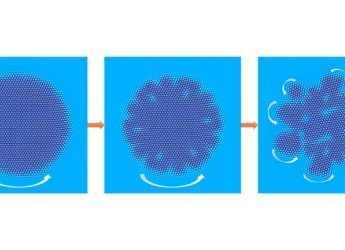- Home
- Science
- Science News
- Physicists Reveal a New Type of Twisting Solid That Behaves Almost Like a Living Material
Physicists Reveal a New Type of Twisting Solid That Behaves Almost Like a Living Material
A collaborative team of physicists from Germany and the U.S. has discovered a groundbreaking form of solid matter called “rotating crystals.”

Photo Credit: Wayne State University/Zhi-Feng Huang
Researchers from Germany and the USA discovered “rotating crystals” — solids that twist, fragment
A wonderful new class of solids composed of spinning particles that exhibit bizarre, lifelike properties has been created by physicists. These “rotating crystals” substances made from numerous particles interacting not by transmitted forces but those acting sideways rather than head on, can twist instead of stretch, shatter while in motion and even reassemble into cohesive wholes. The team of researchers from Aachen, Düsseldorf and Mainz (Germany), together with Wayne State University (Detroit, USA), introduces a comprehensive theoretical concept to predict novel characteristics of systems like these, so-called transverse--interaction systems.
“Rotating Crystals” – Solids That Twist, Break, and Rebuild Themselves
As per Science Daily, these crystals are prone to cleaving easily into individual fragments, impurity grain boundaries and can reveal controllable defects in the structure. They used a multiscale theoretical model to examine how multiple rotating building blocks can couple and lead to behaviour that is qualitatively new and counterintuitive.
New Physics Behind Transverse Interactions and Odd Elasticity Revealed
In ordinary matter, you pull a solid, and the force causes stretching in the direction that's being pulled. On the other hand, an odd elastic material may not stretch in the usual manner but twist under tension. When the spinning building blocks rub against each other with sufficient force, they cause the solid to break into lots of smaller crystallites.
Moreover, they discovered that large crystals dominated by the transverse interaction will tend to fragment into smaller spinning crystals, while small ones grow until they reach a critical size. This is opposite to how normal crystal growth occurs - the crystal grows steadily under good conditions.
The generation of defects in such crystals can be controlled from outside, enabling precise tuning of crystal properties with an eye on applications in areas as diverse as colloid science and biology.
For the latest tech news and reviews, follow Gadgets 360 on X, Facebook, WhatsApp, Threads and Google News. For the latest videos on gadgets and tech, subscribe to our YouTube channel. If you want to know everything about top influencers, follow our in-house Who'sThat360 on Instagram and YouTube.
- Samsung Galaxy Unpacked 2025
- ChatGPT
- Redmi Note 14 Pro+
- iPhone 16
- Apple Vision Pro
- Oneplus 12
- OnePlus Nord CE 3 Lite 5G
- iPhone 13
- Xiaomi 14 Pro
- Oppo Find N3
- Tecno Spark Go (2023)
- Realme V30
- Best Phones Under 25000
- Samsung Galaxy S24 Series
- Cryptocurrency
- iQoo 12
- Samsung Galaxy S24 Ultra
- Giottus
- Samsung Galaxy Z Flip 5
- Apple 'Scary Fast'
- Housefull 5
- GoPro Hero 12 Black Review
- Invincible Season 2
- JioGlass
- HD Ready TV
- Laptop Under 50000
- Smartwatch Under 10000
- Latest Mobile Phones
- Compare Phones
- Redmi K90
- Redmi K90 Pro Max
- Nubia Z80 Ultra
- Realme GT 8
- Realme GT 8 Pro
- iQOO 15
- Red Magic 11 Pro
- Red Magic 11 Pro+
- MacBook Pro 14-inch (M5, 2025)
- Asus Vivobook S16 (S3607QA)
- iQOO Pad 5e
- OPPO Pad 5
- Redmi Watch 6
- Garmin D2 Mach 2
- Xiaomi Xiaomi TV S Pro Mini LED 55 2026
- Xiaomi TV S Pro Mini LED 65 2026
- Asus ROG Ally
- Nintendo Switch Lite
- Haier 1.6 Ton 5 Star Inverter Split AC (HSU19G-MZAID5BN-INV)
- Haier 1.6 Ton 5 Star Inverter Split AC (HSU19G-MZAIM5BN-INV)












